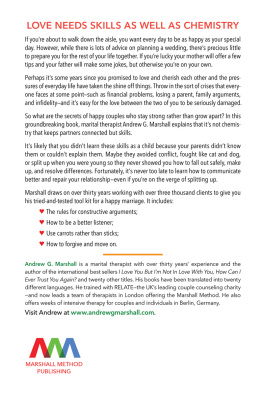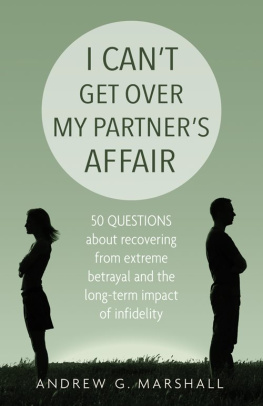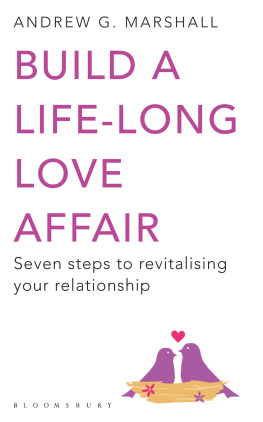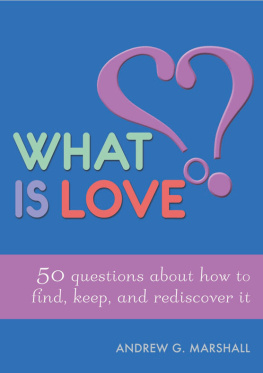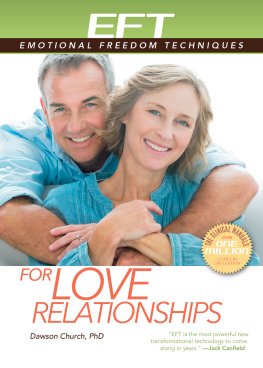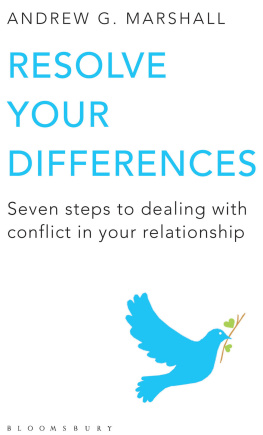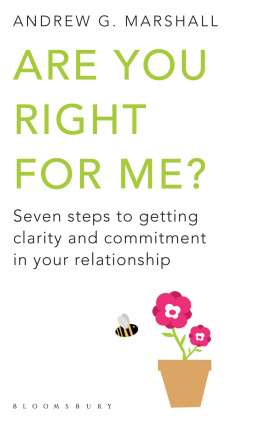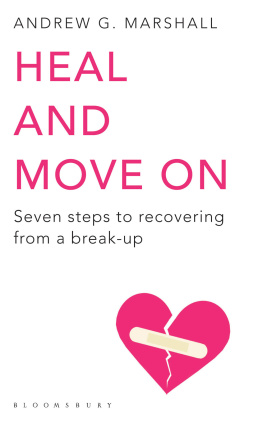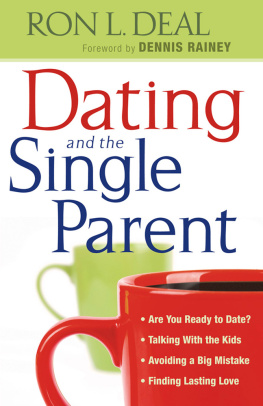Acknowledgements
Thanks for the advice, help and support while Ive been writing this book: Rachel Calder, Jenny Parrott, Richard Atkinson, Erica Jarnes, Natalie Hunt, Ignacio Jarquin, Gail Louw, Chris Taylor, Jamie MacKay, Vanessa Gebbie, Catherine Grace and all the clients and interviewees who contributed to my research.
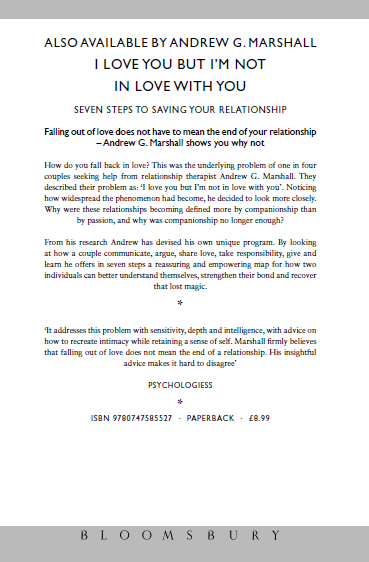
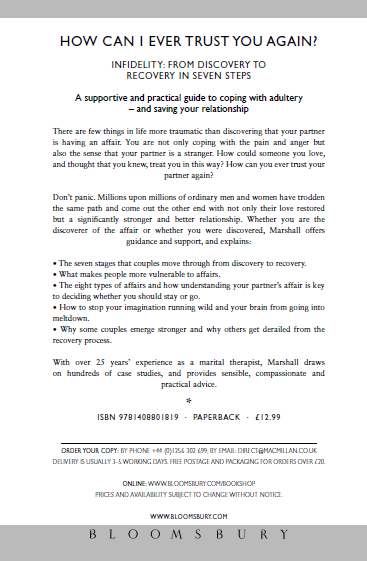
By the same Author
I love you but Im not in love with you
How can I ever trust you again?
Chapter Eight
The Rhythm of Relationships
The good news is that you have been out mixing and either seen someone in a different light or met someone completely new. You have been out together on a few occasions and everything seems promising. But how can you tell if this is just friends or the makings of a lifetime love affair? Fortunately, there is scientific research into just this question, plus useful work on the honeymoon period of love and the natural rhythm of relationships. This knowledge will not only help you progress at the right pace but decide if this new man or woman is the right person for you.
The First Steps in Making a Relationship
What makes the difference between budding love thriving or withering? Researchers John H. Berg and Ronald McQuinn at the University of Mississippi took thirty-eight student couples who had been on five dates and gave them a detailed questionnaire and then repeated it four months later. Berg and McQuinn were particularly interested in the differences between couples who continued to date and those that split up and whether it was possible to predict which group a couple would fall into. Being social psychologists, rather than romantics, they saw relationships in a very functional way: a balance between the benefits of dating and the costs. So they measured not only liking and loving but the rewards of the relationship which they explained as the extent to which your dating partner has helped with problems and projects, and the number of favours exchanged.
The results were very interesting all the couples were unsure about whether they would keep dating. Nobody just knew they were destined to be together. This is something, with the benefit of hindsight, that we retrospectively award to our relationship. The most important difference between continuing and non-continuing couples was the amount of self-disclosure at five dates. In other words, people who were more open and honest rather than just putting on a front or being defensive were the most romantically successful. Human beings are very good at sniffing out a fake and we just do not trust someone who is closed off.
The second difference is a surprise. The continuing couples argued more than the non-continuing ones. Common sense would dictate that conflict would drive people apart. However on further reflection, the findings are fascinating. How well long-term couples handle conflict is the single best predictor for relationship success and it seems the ability to constructively disagree is just as important at five dates as five years. The non-continuing couples were probably swallowing or ignoring the conflict, which fits well with the pattern of low self-disclosure, and storing up problems that would ultimately drive them apart.
The final important finding from Berg and McQuinn is that the rewards of the relationship were not important to any couple at five dates but became much more important at four months. Why should this be? Berg and McQuinn theorise that it takes time to know someones needs and the more needs that are met, the more rewarding the relationship.
So how can you use this research?
Although self-disclosure is good, make certain it is a balanced exchange.
Avoid pouring out your heart while he or she listens. Instead, share a little information as this will encourage him or her to disclose too.
Remember this research is based on five dates and disclosure takes time. So do not expect to achieve everything on your first outing.
Berg and McQuinn illustrate that it is OK to disagree with your date or to have different tastes. For example after a film, you could debate its strengths and weaknesses, rather than feeling that the two of you have to agree on everything.
Hold back on the impressive trips or offering to paint the outside of the house until you know each other. Otherwise, it can seem like an attempt to bribe.
In the same way that it is counterproductive during mixing to judge too quickly, it is equally important to move slowly through the first steps of making a relationship. In effect, there are three types of outings or dates: Getting to know you (assessing if there is any connection), Fun outings (enjoying each others company and checking compatibility) and finally Courting (the beginnings of a lasting relationship). It is impossible to get to the third type of outing without moving through the first two. Unfortunately, many potential relationships are crushed because one half is in too much of a hurry to court. I just like to know where I stand, says Ingrid, who is thirty-two, I havent got time to waste with men who are not interested in a commitment. When I ask how she can judge, she becomes a little coy but after some probing admits: I will float the subject of marriage, perhaps a friend has got engaged and I will see how he reacts. Although Id never ask directly for his opinions on marriage. It might seem casual, to the person dropping the M word, but seldom comes across this way. Jerome is also in his thirties and rarely sees anyone past the third or fourth date. I sometimes think that woman are obsessed with commitment. Sure, I want to settle down, have children, the whole nine yards, but I want it to be with someone who loves me, not with a woman who seems desperate to commit to if I am being brutally honest almost anyone, Jerome explains. I can almost time when the conversation will turn to settling down, marriage, babies or whatever. It is such a turn-off. Im still getting to know her and shes measuring me for a morning suit. On one occasion, he was really keen on a girl that he had met at work. They had been out the night before, but when he arrived at the office Jerome was thinking of calling her. I sat down and logged on for my emails and found that I had two from her. She had left a message on my voice mail; I was still thinking of calling when the phone rang. She wanted to meet me on the third-floor lobby straight away. When I arrived, she shoved a piece of paper into my hand and disappeared. It was a poem dedicated to my soul-mate.
Obviously the time needed to progress from getting to know you to courting will change from couple to couple but as a rule of thumb: it is somewhere between five and ten outings. Around the middle of this period, sex begins to loom large. When to make love is a complex issue. On one hand, good sex is an important ingredient for a successful long-term relationship and you need to test whether the two of you are compatible. However, on the other, sex can easily overwhelm a budding relationship.
Sex and the New Relationship
The 1960s sexual revolution gave women permission to enjoy sex just as much as men something that has improved relationships no end but had the side-effect that some women reversed an old trick. Today I am more likely to counsel women who offer sex as a way of starting a relationship than those who withhold it. Our new understanding of how the brain works from PET scans, MRIs, endocrinological studies and galvanic skin-response tests offers some support for this strategy. Male oxytocin levels (the bonding chemical) are lower than womens, except for one moment: ejaculation.
Next page

